Believe it or not, I have been inside Carnegie Hall only once. In the early 1980s — I forget the year now, as this was the Cambrian Era — I went to see a movie at Carnegie Hall that was accompanied by a piano player. Must have been a silent picture. (If anyone can fill me in on this series, please do so.) In any case I remember exactly nothing about the experience whatsoever. During the summer [2010] I took a quick walk along West 57th from Broadway to 7th Avenue and noticed some classic architecture — nothing built today can compare to it.
When the Google Photo Truck passed Broadway and West 57th, the building on the NW corner was still the General Motors Building at 1769-1787 Broadway. It’s really 2 buildings in one, as the first 3 floors were built in 1923, and the upper 23 in 1927-1928.
In 2010 it has been recast with a glass front as luxury residences, and renamed 3 Columbus Circle, even though it’s 2 blocks south of the actual Columbus Circle.
The Argonaut Building, SE corner Broadway and West 57th, has also been recently redeveloped, but unlike its opposite number across the street, developers have chosen to retain its historic facade.
The former home of the American Society of Civil Engineers and Architects. was constructed in a Beaux-Arts style in 1897. Lee’s Art Shop has been on the ground floor for 4 decades; 57th Street has always been an arts mecca.
They don’t make ’em like this any more, kids. The French Renaissance Art Students League Building at 215 West 57th was built in 1891-1892 for the American Fine Arts Society and the Architectural League. The Art Students League was founded in 1875:
[T]he Art Students League of New York has been instrumental in shaping America’s legacy in the fine arts. Many renowned artists have honed their skills at the League, which is dedicated to sustaining the great tradition of training artists. Today, more than 2,500 students of all ages, backgrounds and skill levels, study at the League each month.
Currently, the League offers more than 130 courses taught by a faculty of approximately 80 artists at its flagship Manhattan location and the Vytlacil campus in Rockland County, where the facilities include a bronze foundry, metal forge, walk-in kiln and welding shop. Throughout the year, students also participate in lectures, seminars and workshops presented by noted figures in the art world. Art Students League
[Students have] included some of the major figures of 20th century American art, including Jackson Pollock, Roy Lichtenstein, Robert Rauschenberg, Georgia O’Keeffe, Man Ray, Mark Rothko, Alexander Calder, Norman Rockwell and Maurice Sendak. Songlines
I liked the marble triple-8s of the plaza belonging to 888 7th Avenue, around the corner. Also known as the Arlen Building, it’s a 46-story glass-front skyscraper completed in 1971. Its best known tenant in recent years was likely 1010 WINS, the all-news radio station, which moved to Hudson Street downtown in 2009. Next door is the Brooklyn Diner, which has gone to a lot of expense to look like many of the authentic diners that have disappeared from the Manhattan scene in recent years such as the Cheyenne, the River, the Munson, the Moondance …
On the SW corner of 7th and West 57th is the neo Gothic building formerly home to Rodin Studios, named for the famed French sculptor Auguste Rodin, whose best known work is The Thinker. It was constructed in 1916-1917 by architect Cass Gilbert to provide living space for professional artists. It became an office building in 1968.
Directly opposite Rodin Studios and catercorner to Carnegie Hall is the Osborne Apartments, built mostly from 1883-1885 with a top floor addition in 1889, and a further extension west in 1906, one of the finest brownstone apartment buildings in the city.
Period photographs indicate that the building’s exterior has suffered much over the years. The three large protruding courses once supported very handsome balustrades. The top one, the widest, was meant to serve as a cornice although it was actually two stories beneath the roofline in an attempt to make the building seem somewhat smaller than it actually was. A much more modest cornice was at rooftop. The rooftop, incidentally, was not originally even, and was higher on 57th Street than on Seventh Avenue. Subsequently, the whole of the Seventh Avenue cornice line was raised to add rooms on the top floor.
The building originally was planned to have a billiard room, a florist, a resident doctor and druggist and “on the roof, a lawn for playing croquet,” according to a Real Estate Record and Guide article in 1884 quoted by Andrew Alpern in his essay on the building in his excellent book, “Luxury Apartment Houses of Manhattan, An Illustrated History,” 1992, (Dover Publications Inc., New York).
The developer, Thomas Osborne, was a stone contractor but he ran into financial difficulties during construction. A February 6, 1994 column by Christopher Gray in The New York Times remarked that “this huge clunky mass neatly defeats stylistic description, and it is really the vernacular of the practical building, quite innocent of aesthetic pretension,” adding that The Real Estate Record & Guide, “unappreciative of the comic transparency of Osborne’s effort, called the facade ‘crude and unskillful.’
The building was completed by John Taylor, a hotel operator. James Edward Ware was the original architect and Alfred S. G. Taylor and Julien Clarence Levi were the architects for the 1906 extension. City Realty
Many famous names have occupied The Osborne over the decades. Tragically, Oscar winner Gig Young killed his wife and committed suicide here in 1978.
I have attained Carnegie Hall and didn’t even need to practice. It is steel magnate/philanthropist Andrew Carnegie’s finest city legacy (and he left behind dozens of handsome library buildings that he funded). It closely followed the Osborne and was constructed from 1889-1891 witha separate studio wing in 1897. The authors of the AIA Guide to New York City don’t much like it, calling it a “dour Renaissance Revival,” “world-famous more for its acoustics than for its architectural envelope.”
Carnegie Hall is one of the last large buildings in New York built entirely of masonry, without a steel frame; however, when several flights of studio spaces were added to the building near the turn of the 20th century, a steel framework was erected around segments of the building. The exterior is rendered in narrow Roman bricks of a mellow ochre hue, with details in terracotta and brownstone. The foyer avoids contemporary Baroque theatrics with a high-minded exercise in the Florentine Renaissance manner of Filippo Brunelleschi’s Pazzi Chapel: white plaster and gray stone form a harmonious system of round-headed arched openings and Corinthian pilasters that support an unbroken cornice, with round-headed lunettes above it, under a vaulted ceiling. The famous white and gold interior is similarly restrained. wikipedia
Page completed November 2, 2010

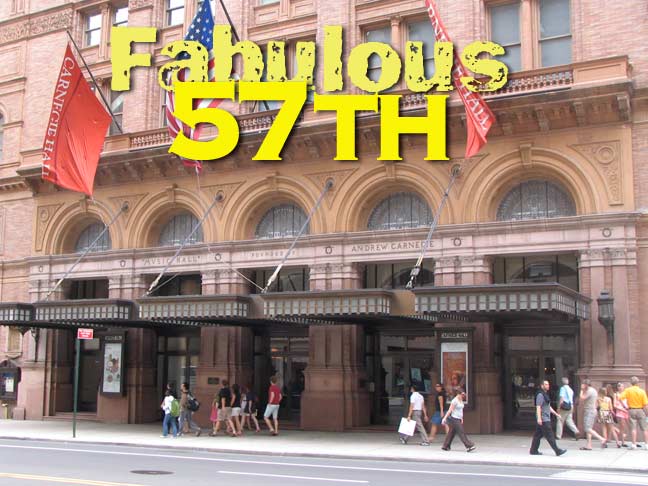



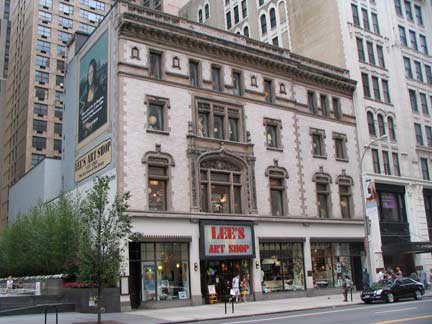



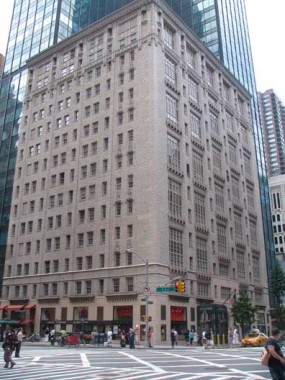

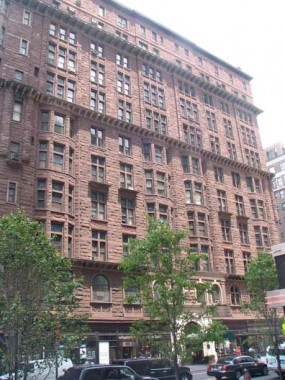
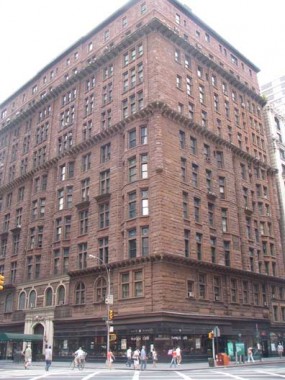
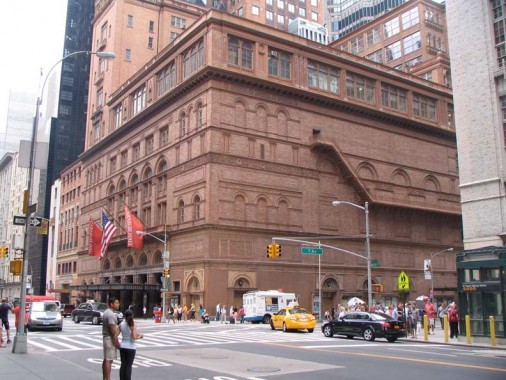
4 comments
I attended the Art Student’s League and my teacher was Hal Foster Jr. HIS dad, the senior, met MY dad in the 1930’s!
In 1973 I graduated from Adlai E Stevenson High School from the Bronx at Carnegie Hall.What a thrill to walk across that stage.Also attended a few concerts there-Judy Collins,Chuck Berry,Jerry Lee Lewis and a Young Peoples show featuring the Orchestra and Elephants Memory with Frank Zappa(I was in Jr High and had no idea who he was)
I saw Sweet Honey in the Rock at Carnegie Hall in the early 1990s. I remember everything about it, including taking in the incredible interior visuals while my ears were gifted by those melodious voices.
Provided a Hamburg Steinway Model D-274 there for sessions in which Bob Dylan and Mark Knopfler were the main attractions. For me, in-between touch-up tunings, the main attraction was Diana Ross, seemingly always prowling the hallways when I was out there. We of course talked and talked, and she said, “Ricard I’m so hungry.” I said, “Well, do you like great Italian food?” “Of course she replied.”
So, I told her I’d be back in 30 minutes, darted over to Patsy’s on W. 56th Street (where I more or less ate every night in those days) and brought back a 3 course meal. We spread it all out on road cases in the hallway, and just had an absolute blast. She was one of the sweetest music women I’ve ever met.